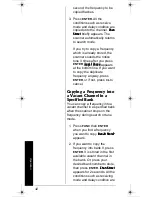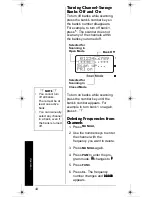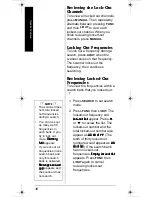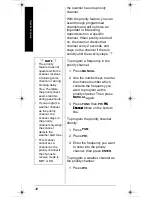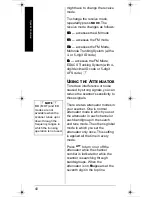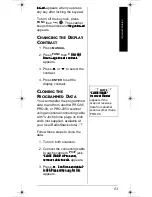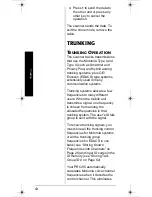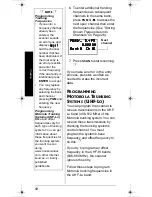
Tr
unki
n
g
56
specific frequency to transmit on,
a trunked system chooses one of
several frequencies when the
2-way radio user transmits. The
system automatically transmits the
call on that frequency, and also
sends a code that identifies that
2-way radio user's transmission on
a control channel.
Your scanner lets you easily hear
both the call and response
transmissions for that 2-way radio
user and therefore follow the
conversation. For EDACS and
Motorola (above 406 MHz range),
the scanner monitors the control
channel between each
transmission to identify talk groups.
5
'66+0)
"
5
37'.%*
"
(14
"
6*'
"
6
470-+0)
"
/
1&'
Your scanner automatically mutes
the audio during trunk scanning
when it decodes control channel
data. However, we recommend
you turn
SQUELCH
clockwise and
leave it set to a point just after the
hissing sound stops. This lets the
scanner quickly acquire the data
channel.
2
41)4#//+0)
"
6
470-+0)
"
(
4'37'0%+'5
You program trunking frequencies
the same as non-trunked
frequencies, except that you must
store the appropriate mode (MOT
or ED) with each frequency.
±
Follow these steps to program
trunked frequencies:
±
"
016'
"
±
"
•
You can scan only
one type of
trunked frequency,
either EDACS or
Motorola in a bank
at one time. You
can, however, mix
conventional
channels and
frequencies in a
bank.
•
If you are
programming
trunked
frequencies for
Motorola Type I
and hybrid
systems, you must
first program the
fleet map (see
“Programming
Fleet Maps” on
Page 60).
•
If you are
programming
frequencies for an
EDACS system
you must store
them in the
Logical Channel
Number order
(usually listed as
LCN#). For
example, LCN1
would go into
channel 01 for the
current bank, and
LCN2 would go
into channel 02.
20-525NEW.fm Page 56 Monday, July 1, 2002 2:58 PM

